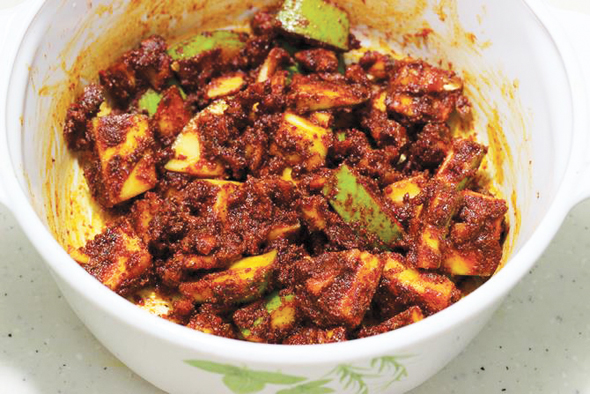Mama’s Punjabi Recipes: Amb Da Achaar (Green Mango Pickle)
It goes without saying that Indians love pickles but it may come as a surprise that there are probably a hundred different types of pickles found all over the country. There are even pickles made of different meats: mutton, pork, quail, partridge, shrimp and lobster. Even though many of the spices and oils used are the same, the end result and taste of the pickles is very different.
One of the reasons for the variety of pickles is the abundance of sunshine which not only helps the fruits and vegetables grow, but is a powerful source of natural solar heat that allows the pickles to ferment in the rays of the sun within a few days.
A pickle loved universally across the country is the uniquely Northern Indian amb da achaar (green mango pickle). To make the authentic pickle, you need to use small dark green, round shaped, sour unripe mangoes with a softer shell that protects its giri (seed). In India, these achaar wale mangoes are available from April through July. But if you don’t find them, use any green unripe mangoes, but make sure they are sour.
Raw green mangoes offer many health benefits: they help with weight loss, reduce morning sickness, acidity, constipation, scurvy, prickly heat, excessive sweating and mineral loss, provide energy, and are good for the liver, immune system, the teeth and diabetics. They are rich in fiber, vitamin A, beta-carotene and antioxidants which help maintain healthy skin and mucus membranes. But beware that due to the sap in them, eating too many can also irritate the throat, give indigestion, dysentery and abdominal colic.
In India, it is not uncommon to find people making amb da achaar in their homes and store them till the next season. My 83-year-old mother, Biji, would make some every year and the pungent smell of green mangoes, mustard oil, salt and saunf (fennel seed) would waft through the house! She would pack the pickle in a tall ceramic biyaam (jar) and set it in the sun for a few days, shaking the contents to mix in the spices every so often. When it was ready, we’d all get spoonfuls with our meals and after chewing off the skin and flesh, suck on the spices soaked in the whiskers of the gutli (shell). Uum-huh! That was to die for!
Ingredients:
• 5 large amb (mangoes) – pickling type, from Indian stores
• 2 tbsp methi dana (fenugreek seeds) powder
• 2 tbsp saunf (fennel seed)
• 1 tbsp lal mirch (red pepper)
• 1 tbsp namak (salt)
• ½ tsp haldi (turmeric)
• ½ tsp kalonji (onion seed) (if available)
• ½ cup sarson ka tael (mustard seed oil)
• ½ cup white vinegar
Directions:
1. Wash the mangoes and dry them with a cloth and spread them out so that all the water is dried off. It is important not to leave any water on the mangoes as this will cause the pickle to not last long and spoil soon.
2. Cut the dry mangoes into 1 inch pieces. If you can, carefully cut the shell into halves.
3. Now prepare the masala for the pickle. Put the methi dana and the saunf in a blender and set it to chop.
4. Pour the mixture into a bowl and add the rest of the spices and mix thoroughly with your hands.
5. Add in the cut mango pieces and mix with your hands to coat them well.
6. Pour the vinegar into the jar you will make the pickle in and swirl it around to coat the inside of it.
7. Pour in the coated mango pieces close the lid tightly and shake well. Set the jar in the sun to allow the heat to ferment it for 4 or 5 days, shaking the contents vigorously a few times each day. If there is no sunshine, place indoors in a warm place.
8. After a week, open the jar and add the mustard seed oil and shake well again so that the mangoes are covered by the oil.
9. Store the jar in a warm spot in the pantry for 3 to 4 weeks so that the green mangoes can ferment.
10. After a month, the ambh da achaar is ready to eat and will keep for up to a year without refrigeration.
MAMA’S TIP OF THE WEEK: USE RAW MANGO AND PAPAYA JUICE AS A SALAD DRESSING
For those who are watching their diet and trying to lose some weight, salads are a common alternative to a heavy meal. But even though the ingredients in the salad may be low-calorie, often the dressing contains much more which makes it less healthy than you can imagine!
Next time, try a little green mango or green papaya juice instead of a regular dressing and add in the spices of your choice. These are high in fiber and contain higher amounts of digestive-resistant starch, which is important for good gut bacteria. These resistant starches do not result in blood sugar spikes and help improve insulin regulation, reducing the risk of insulin resistance.

Shakuntla Malhotra is a skilled cook of Punjabi dishes made in the old-fashioned style that she learnt as a young woman in her ancestral home in Lyallpur, India (since renamed Faisalabad) before it became part of Pakistan after the Partition in 1947. People have often admired her cooking for its simplicity and taste that comes with each mouthful. Even in her late-eighties, she continues to cook daily and agreed to share her delectable Punjabi recipes for future generations.

